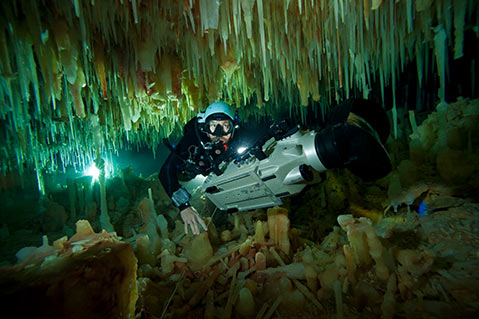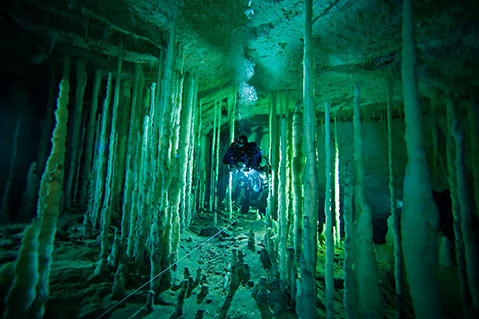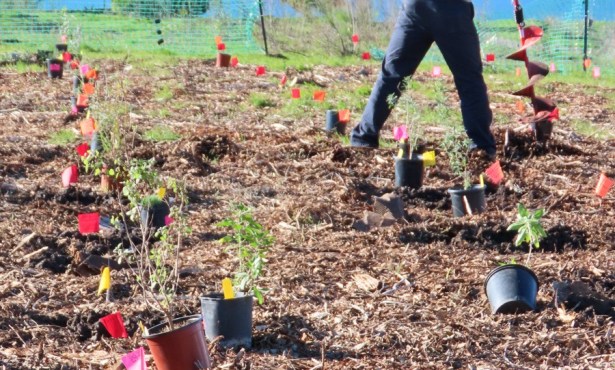Kenny Broad Finds Magic in Underwater Caves
Nat Geo Explorer on the Wonder and Scientific Value of These Mysterious Caverns

“I could give you a bunch of rational, scientific, and conservation reasons, but it’s the feeling of being somewhere that no one has been before, drifting through this most peaceful, delicate, inner space, with all my focus on the task at hand,” said Kenny Broad of why he is drawn to the extreme and often dangerous discipline of exploring underwater caves. But Broad, who holds a PhD in anthropology from Columbia University and is a professor at the University of Miami, also sees the scientific knowledge gained by probing these rarely charted territories. Broad was in the Bahamas studying “blue holes” when I caught up with him over email.
When did you become interested in exploring underwater caves? I grew up in Florida, which is made up of limestone — the best type of rock for extensive cave formation. My neighbor was a professional diver, so at about 11 years old I realized you can breathe underwater and escape the confines of gravity, and basically I became addicted early on. As I received more formal training, the mysterious aura of cave diving was always in the background, and I was introduced to some of the cave-diving pioneers when I was about 19 years old and quickly realized that there was another world right beneath my feet.
What can underwater caves tell us about the environment and/or geological history? Many of the caves, what are referred to as “blue holes” in the Bahamas, “cenotes” in Mexico, or “sinkholes” in the U.S., are really time capsules along many dimensions. The cave formations, stalagmites, and sediments in particular are recorders of environmental history such as temperature and rainfall. The speleothems form when the cave was dry during past ice ages and the sea level was much lower, so sometimes we find the caves inland and sometimes in the coastal areas. With these samples, we can do geochemical analyses to reconstruct past climate, going back hundreds of thousands of years. This allows us to better understand natural climate variability and thus make more sense of what is happening now as we put greenhouse gasses into the atmosphere.
The microbial life in some of these caves can also help us understand what some of the earliest forms of life were like going back over three billion years as some of these sinkholes are modern-day equivalents of the ancient, primordial oceans that life evolved out of. They are also earthly analogs for environments that may exist on other planets, so the astrobiologists are also studying these extremophile forms of life.
The biogeochemistry in some of these caves are salt water and anoxic (no oxygen), thus they are the ideal medium for preserving fossils. Beyond the scientific value, these caves are windows into our freshwater reservoirs — aquifers. Diving in them can shed light on what’s arguably our most critical resource, fresh water. Blue holes are one-stop shopping for geology, biology, and paleontology and for understanding the extent of and the threats to our drinking water supply.

The Bahama blue holes avalanche looked so frightening. How do you find the courage to return to cave diving after experiencing something like that? It’s a lot scarier — and, objectively, more dangerous — driving on the highways in Florida where I live than cave diving. You mentally train for different underwater scenarios and hope that your muscle memory kicks in and is not overwhelmed by adrenalin. When things go south, we take a couple of slow, deep sanity breaths before dealing with problems, and that seems to keep the heart rate down and the mind under control. It works on the surface, too.
What is the most beautiful cave you’ve ever seen? Why? I guess my bias is that the most beautiful underwater caves are in the Bahamas because of the diversity of what you see and types of caves, from ocean holes that boil up to the surface or have whirlpools depending on the tides to caves found inland in the rock pine lands that go for miles in every direction — decorated with crystals, flowstone, and speleothems — to deep canyon caves with the ceiling at 40 feet and the bottom at 400 feet and you feel like you’re swimming through the Grand Canyon.
Where are you set to explore next? Are there any caves you haven’t visited but hope to? Bob Ballard, along with Lynn Gamble from UCSB and folks at the Channel Islands Marine Sanctuary among others have expeditions planned for 2017 to the Channel Islands to study the undersea caves that have formed primarily from wave actions during past sea level stands, so I’m hoping to join them as these are new areas for me. They are not extensive cave systems like the ones we normally work in, but they could hold really interesting clues to past human and non-human inhabitation and previous rates of sea level change, among other things. I’d be thrilled to participate, even if it’s doing dishes and cleaning toilets, as there’s always something to learn when you get a group of experts together and go to new places.
4·1·1
As part of Arts & Lecture’s National Geographic Live series, Kenny Broad will present The Risky Science of Exploration Sunday, January 8, 3 p.m., at UCSB’s Campbell Hall. Call (805) 893-3535 or see www.artsandlectures.sa.ucsb.edu.



